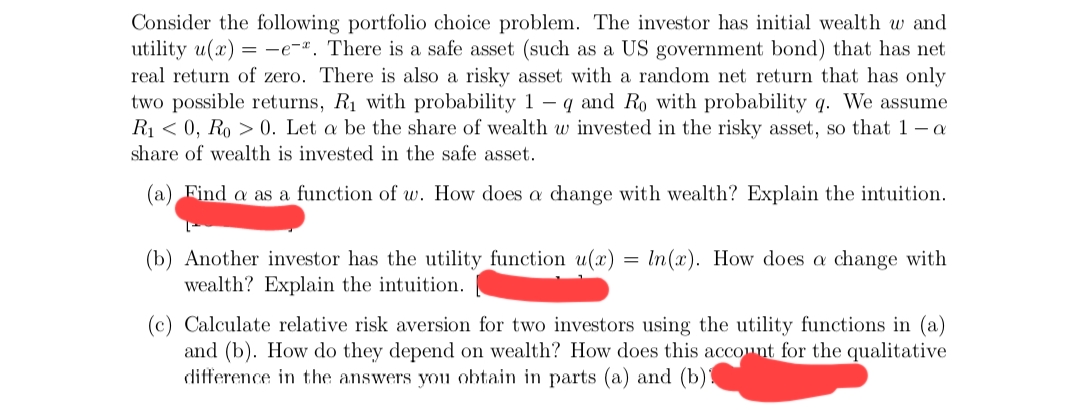Consider the following portfolio choice problem. The investor has initial wealth w and utility u(x) = -e-". There is a safe asset (such as a US government bond) that has net real return of zero. There is also a risky asset with a random net return that has only two possible returns, R1 with probability 1- q and Ro with probability q. We assume R1 < 0, Ro > 0. Let a be the share of wealth w invested in the risky asset, so that 1 - a share of wealth is invested in the safe asset. (a) Find a as a function of w. How does a change with wealth? Explain the intuition. (b) Another investor has the utility function u(x) = In(x). How does a change with wealth? Explain the intuition. (c) Calculate relative risk aversion for two investors using the utility functions in (a) and (b). How do they depend on wealth? How does this account for the qualitative difference in the answers you obtain in parts (a) and (b)
Consider the following portfolio choice problem. The investor has initial wealth w and utility u(x) = -e-". There is a safe asset (such as a US government bond) that has net real return of zero. There is also a risky asset with a random net return that has only two possible returns, R1 with probability 1- q and Ro with probability q. We assume R1 < 0, Ro > 0. Let a be the share of wealth w invested in the risky asset, so that 1 - a share of wealth is invested in the safe asset. (a) Find a as a function of w. How does a change with wealth? Explain the intuition. (b) Another investor has the utility function u(x) = In(x). How does a change with wealth? Explain the intuition. (c) Calculate relative risk aversion for two investors using the utility functions in (a) and (b). How do they depend on wealth? How does this account for the qualitative difference in the answers you obtain in parts (a) and (b)
MATLAB: An Introduction with Applications
6th Edition
ISBN:9781119256830
Author:Amos Gilat
Publisher:Amos Gilat
Chapter1: Starting With Matlab
Section: Chapter Questions
Problem 1P
Related questions
Question

Transcribed Image Text:Consider the following portfolio choice problem. The investor has initial wealth w and
utility u(x) = -e-ª. There is a safe asset (such as a US government bond) that has net
real return of zero. There is also a risky asset with a random net return that has only
two possible returns, R1 with probability 1 - q and Ro with probability q. We assume
R1 < 0, Ro > 0. Let a be the share of wealth w invested in the risky asset, so that 1 – a
share of wealth is invested in the safe asset.
(a) Find a as a function of w. How does a change with wealth? Explain the intuition.
(b) Another investor has the utility function u(x) =
wealth? Explain the intuition.
In(x). How does a change with
(c) Calculate relative risk aversion for two investors using the utility functions in (a)
and (b). How do they depend on wealth? How does this account for the qualitative
difference in the answers youu obtain in parts (a) and (b)!
Expert Solution
This question has been solved!
Explore an expertly crafted, step-by-step solution for a thorough understanding of key concepts.
This is a popular solution!
Trending now
This is a popular solution!
Step by step
Solved in 3 steps with 3 images

Recommended textbooks for you

MATLAB: An Introduction with Applications
Statistics
ISBN:
9781119256830
Author:
Amos Gilat
Publisher:
John Wiley & Sons Inc

Probability and Statistics for Engineering and th…
Statistics
ISBN:
9781305251809
Author:
Jay L. Devore
Publisher:
Cengage Learning

Statistics for The Behavioral Sciences (MindTap C…
Statistics
ISBN:
9781305504912
Author:
Frederick J Gravetter, Larry B. Wallnau
Publisher:
Cengage Learning

MATLAB: An Introduction with Applications
Statistics
ISBN:
9781119256830
Author:
Amos Gilat
Publisher:
John Wiley & Sons Inc

Probability and Statistics for Engineering and th…
Statistics
ISBN:
9781305251809
Author:
Jay L. Devore
Publisher:
Cengage Learning

Statistics for The Behavioral Sciences (MindTap C…
Statistics
ISBN:
9781305504912
Author:
Frederick J Gravetter, Larry B. Wallnau
Publisher:
Cengage Learning

Elementary Statistics: Picturing the World (7th E…
Statistics
ISBN:
9780134683416
Author:
Ron Larson, Betsy Farber
Publisher:
PEARSON

The Basic Practice of Statistics
Statistics
ISBN:
9781319042578
Author:
David S. Moore, William I. Notz, Michael A. Fligner
Publisher:
W. H. Freeman

Introduction to the Practice of Statistics
Statistics
ISBN:
9781319013387
Author:
David S. Moore, George P. McCabe, Bruce A. Craig
Publisher:
W. H. Freeman